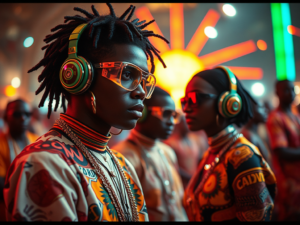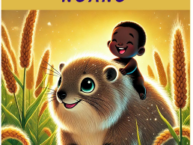 Afrofuturism, or simply African Futurism, was the main theme for the 2025 National Arts Merit Awards (NAMA) in Zimbabwe. It was an awakening, as it became clear that the judges made their selections for nominations and winners according to this cultural trend. Do Zimbabwean–or African–artists fully grasp the art of Afrofuturism? To look into the movement within the Zimbabwean context, Beaven Tapureta (BT), a literary journalist, had a conversation with award-winning author Primrose Dzenga (PD). Her latest book Chimbira nedzimwe Ngano won the 2025 NAMA Award in the Outstanding children’s book category.
Afrofuturism, or simply African Futurism, was the main theme for the 2025 National Arts Merit Awards (NAMA) in Zimbabwe. It was an awakening, as it became clear that the judges made their selections for nominations and winners according to this cultural trend. Do Zimbabwean–or African–artists fully grasp the art of Afrofuturism? To look into the movement within the Zimbabwean context, Beaven Tapureta (BT), a literary journalist, had a conversation with award-winning author Primrose Dzenga (PD). Her latest book Chimbira nedzimwe Ngano won the 2025 NAMA Award in the Outstanding children’s book category.
BT: How would you define Afrofuturism?
PD: Thank you so much, Beaven, for this question. Afrofuturism, as a term, has its origins in the 1990s and was initially focused on the African diaspora. It was a fusion of African themes—blackness, black art—with technological advancements and resources available to black folk in the diaspora. As it evolved, it began to encompass themes of dystopia—exploring African pain and turning that into speculative fiction or art, often using modern technology, like electronic music or, in my case, Artificial Intelligence (AI). For me, Afrofuturism is about taking authentic African voices and expressions—like our folktales (Ngano)—and leveraging digital tools to enhance how we produce and present art. For instance, in my children’s book Chimbira nedzimwe Ngano, I compiled six authentic Shona folktales and used artificial intelligence to bring them to life. I used Otter AI for narration, ChatGPT for illustrations, and Canva for the book design. The beauty of Afrofuturism, especially for artists on the continent, is that it’s not a question of choosing between Africa and futurism. It’s about using global tools and resources to ensure our art is part of the global conversation—accessible, relatable, and relevant. For me, the present is as much the future as the past is.
BT: Does Afrofuturism inspire you?
PD: If you had asked me the question two or three years ago, I might not have had an answer. But outside of writing, I’m also a development scholar and practitioner. I’ve been particularly focused on the digital divide that leaves out around 570 million Africans from the technology market—this includes visual art, literary work, film, television, dance, and spoken word.
So yes, Afrofuturism deeply inspires me because I see it as a tool for rescuing and elevating the vast knowledge and creative genius within Africa that often goes untapped due to lack of access to digital technology.
BT: What is Afrofuturism’s background in Zimbabwean arts, and do you recall any events or works that had an Afrofuturistic influence?
PD: Zimbabweans are incredibly forward-thinking and innovative. One globally recognized Afrofuturistic project is the Black Panther film, which featured our very own Danai Gurira. Before that, she played Michonne in The Walking Dead, a role filled with futuristic and Afrocentric symbolism.
Danai starred in both Black Panther films, which even used 3D printing for costumes inspired by South African royal regalia—an amazing fusion of tradition and technology.
On a local level, I think of Urban Grooves with artists like Nonsikelelo’s, Sisonke, and the Makalima Boys. They use artificial intelligence generated electronic beats mixed with Shona and English—creating what we often call “Shonglish.” Their music speaks to a global stage where Africa contributes meaningfully to the global village and vice versa.
Then there are digital creatives like Fungai Tichawangana, who was already blending technological arts with marketing and writing as far back as 2010. Zimbabwe has truly been at the forefront—not just in literature, but across the arts.
BT: In literature, how would you tell if a work has incorporated an Afrofuturistic theme or element?
PD: Afrofuturistic elements can be in the story itself, the design, or even the technology used in the production. A recent short story that really struck me is Haru’s Homecoming by Samantha Vazhure, published in Munyori Literary Journal. It’s set in Chivi, where a family is conducting a Kurova guva (memorial ceremony). The goat meant to confirm the spirit’s acceptance doesn’t respond—later revealed to be pregnant, which breaks the ritual rules. What made it Afrofuturistic for me was the presence of family from the diaspora—one of whom records the ceremony with a camcorder. He initially mocks it as foreigners typically do, but in doing so, captures and preserves traditional Shona culture on film. That blend of old ritual and modern technology is the essence of Afrofuturism.
BT: I think it was timely that the NAMA Awards in Zimbabwe chose Afrofuturism as its 2025 theme. How can artists further make Afrofuturism a vibrant cultural movement locally and abroad?
PD: Like you, I think it was timely that the NAMA Awards chose Afrofuturism as the 2025 theme. As I read more on Afrofuturism, I learned that its origins explore how African art has often been seen as a relic of the past—something static that hasn’t progressed. But that stagnation is more about a lack of resources than initiative or adaptability. I want to speak about promotion and resources. Despite Zimbabwe’s current economic challenges, it is my deepest hope and prayer that the National Arts Council of Zimbabwe, across all arts sectors—literature, music, and more—begins to create platforms that encourage artists to embrace technology. Even something as basic as uploading performances to YouTube, Vimeo, Instagram, or Facebook can bring our art to the global stage.
Until now, Afrofuturism has been seen largely as a diasporic art movement—an expression of what diasporic Africans, such as African Americans, have preserved from their ancestors (what the enslaved brought from Africa), fused with modern technology and Western production techniques. But for me, Afrofuturism is limitless.
For instance, I’ve used artificial intelligence to tell authentic Shona folk tales—Chimbira nedzimwe Ngano—recording and illustrating them using AI tools. I’m not a visual artist, but AI helped me illustrate my own book and bring my vision of African characters to life. These aren’t the typical distorted Moorish silhouettes often used to represent Africans—they are joyful, mischievous, well-formed children and people, like the dancing hornbills in Makumbo Dendera.
This silhouetting of African identity with deformed images in global art reflects the distortion and marginalization of the African and African art, and that needs to change. If Africa is the true cradle of civilization and humanity, then our art should have a prominent place—not just in storytelling but also in the economic gains art can bring.
So again, I appeal to the National Arts Council of Zimbabwe: please create platforms that enable rural artists to use technology to elevate their work. It is needed.
BT: Should Afrofuturism be a once-off theme? Who are the other stakeholders expected to integrate it into their work or rather develop it?
PD: That’s a great question, Beaven. Afrofuturism shouldn’t be a one-off. Personally, I’d love to see it run for at least five years—from 2025 through 2030. That’s about how long it takes for a movement to gain traction and begin to yield rewards.
Extending the theme would allow Zimbabwean artists to develop an authentic African artistic mindset—blending our rich culture with digital and electronic formats because the whole world is now digital. As a development practitioner and academic, I’ve seen that even grant applications now are entirely online. “Click here to apply” is the new standard.
If our artists can’t enter that digital space—if they can’t use technology to produce, market, and collaborate beyond borders—we’re fighting a losing battle. We’ll be left behind, stuck in a one-dimensional, silhouetted representation of Africa.
Representation matters. Our children deserve to see themselves in heroes, in books, and in art. Right now, most of the books they read and the rhymes they sing don’t reflect who they are. Why is that? As Chimamanda Ngozi Adichie warned about the danger of a single story, we need to swim against that current through art that speak to our children’s realities with inspiration and grace. A one-off theme is not enough. We need a sustained, intentional Afrofuturist vision to reshape the narrative and to give others especially rural artist time and opportunity to catch up.
BT: There have been a lot of online discussions and lectures on what’s called ‘ancestral intelligence’ which is being celebrated as the original AI. How can Zimbabwean writers balance ancestral intelligence with artificial intelligence in their creativity?
PD: This is the first time I’m hearing it called “ancestral intelligence.” I knew it as indigenous knowledge, but I love the term. My colleague Ignatius Mabasa, a storyteller like me, and I, refer to it as distilled wisdom—exactly what (AI) or large language models do: read vast amounts of data and distill meaning. My book Chimbira nedzimwe Ngano is a good example of how we can balance ancestral intelligence with artificial intelligence. I took traditional Shona folktales and used AI to record, enhance, and distribute them—bringing ancient knowledge into the modern world and global stage. I also love Vazhure’s Haru’s Homecoming, which captures ceremonial rituals using film in a modern way. Or look at Danai Gurira’s character in Black Panther—how that film told the story of the Dahomey female warriors, a deeply African essence and piece of history, yet adapted for global consumption.
Zimbabwean writers can follow two approaches: Use AI as a medium for traditional stories (like I did), or integrate AI into the narrative structure, like Samantha does in her writing.
But above all, we must unlearn the internalized shame and perpetuation of calling our ancestral knowledge “primitive.” Instead, we should tap into that intelligence, wisdom and knowledge—preserved in our stories, our rituals, and our art—and repackage it for ourselves and for the world.
BT: There are celebrated Zimbabwean writers in the diaspora. What role can they and their diasporic experiences play in developing Afrofuturism back home?
PD: I’m constantly amazed by the diaspora’s thirst to reconnect with home. I know Danai Gurira has worked with the Almasi Theater, helping writers develop and record stage scripts—which is Afrofuturist in nature. Many successful global films started as stage plays, later recorded for screen. This makes performance art more accessible to Zimbabweans who can’t physically attend the theater.
Personally, I’d love to host workshops, maybe during the Zimbabwe International Book Fair, where I can teach other artists how to use free AI tools to enhance their art.
I’m also developing, with colleagues, an offline digital server called the TOPS Server. It’s AI-enabled and perfect for artists in rural communities. Anyone within 50 meters of the server—if they have a phone, tablet, or laptop—can download, download, create and upload multi-media art. The server connects to the cloud, where the work can be shared online or stored locally.
Diasporic writers and developers can support initiatives like these—bridging access, technology, and cultural authenticity. Because Afrofuturism isn’t just about imagining Africa’s future—it’s about equipping Africans to create that future today.
BT: Could there be opposing versions or expressions of Afrofuturism?
PD: Yes, for sure. For example, in reading more about Afrofuturism, I’ve noticed that a lot of it is portrayed through dystopias or framed around African pain and hurt, explored through speculative fiction filled with technology and electronics. But for me, Afrofuturism is a celebration of our place in the world—a world we’ve always inhabited. It’s not something new. Afrofuturism, to me, is the fullness of Africa coming into the global conversation, taking its rightful place, and saying, “We have always been here.” Our stories are timeless. They are classic, they are contemporary. They are global.
I was recently talking to Dr Ignatius Mabasa, who is also a storyteller, and we went through different stories (Ngano) that we’ve shared in various places. In each one, you find lessons that are not just local—they’re global, contemporary and timeless from a thousand-year-old stories. For example, Ignatius tells the story of Amai Ndakanaka, a woman and her daughters who fall under a spell and become obsessed with their beauty, dancing around a well after seeing their reflections. That story speaks to today’s selfie culture and our obsession with beauty—something affecting both adults and children.
Another is Karinga, a story in Chimbira nedzimwe Ngano, about a girl who gets tricked by baboons to cross the river with a promise of beads—once across the river they turn the river into boiling water, and she is trapped and has to be rescued using a rocket (Chitundumuseremusere). It reflects modern dangers like online grooming and human trafficking—especially how people, including children, are lured by false promises of jobs in places like Dubai and then end up in modern-day slavery. These stories show that Afrofuturism isn’t simply a song of mourning. It’s a celebration. It’s Africa saying, “We have arrived, we have always been here. We’ve always belonged. Our stories are not a sideshow.
BT: What do you think are some of the weaknesses of Afrofuturism? And how can they be resolved?
PD: Well, one challenge is that Afrofuturism is often technically defined as a diasporic art. That can be divisive, making Africans on the continent feel left behind—again reinforcing this outdated narrative that Africa is lagging behind.
Another major issue is access—both economic and technological. A lot of Afrofuturism involves digital creation, sharing, and performance. But about 70% of Zimbabweans live in rural areas without consistent electricity or internet access, except maybe through their mobile phones. This is true across much of Sub-Saharan Africa, where over 50% of people live in rural areas. That’s roughly 570 million people left out of the Afrofuturism conversation simply because they lack access.
From a development perspective, I and others have created off-grid technologies that can bridge this gap. We shouldn’t wait ten years for universal rural electrification or internet. The future is now. The present is the future. Let’s merge artificial intelligence with off-grid tools—like the TOPS server—and combine that with African art, education and creativity. This can expand Afrofuturism beyond a diasporic expression of Blackness to include the African expression of Africanness. Together, all of those of African descent we make Africanness whole in the global space.
BT: What advice or guidance would you give to writers, scholars, and all artists interested in embracing Afrofuturism in their work?
PD: Just last month, I was part of an international panel called ‘Making Space: Exploring Space Law, African Speculative Fiction and the Future of Storytelling’, where we discussed a synopsis of the first Nigerian—or Nollywood—sci-fi film featuring a Black female lead in the Space race and African sci-fi and speculative fiction. This is groundbreaking. We’ve seen many Nollywood films, but none have really ventured into sci-fi with a woman at the center. It’s momentous. But we have also always had African space aspirations like the Rozvi using scaffolds to try and get to the moon.
So, what I’d say is this: Free yourself from the internalized harmful narrative that African means backward, acknowledge that our stories have power. They are beautiful. They have always been here. Embrace the idea that there is no limit to what we can do as African artists, scholars and people.
The discussion Making Space literally explored space travel, the space race—topics of world leadership, tech, and science. Just like Black Panther did. So, I wouldn’t give prescriptive guidance, but I would offer this: embrace the Africanness in you. Celebrate it. Let it live in your scholarship, your art, your writing. And always remember we belong here. We’ve always been here. Our past and our present are the future.
BT: Thank you so much, Primrose. It’s always mind-opening talking to you.
PD: You’re welcome.



